 |
JAVA: Socket Programming |
| << JAVA Applets |
| JAVA: Serialization >> |
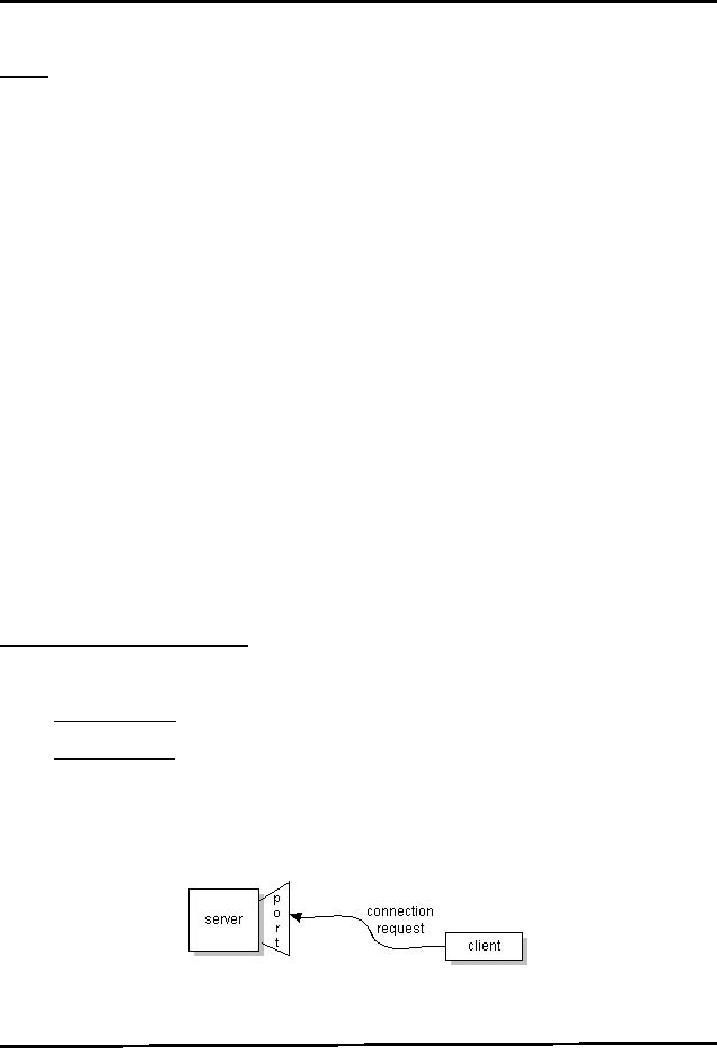
Web
Design & Development CS506
VU
Lesson
21
Socket
Programming
Socket
A
socket is one endpoint of a two-way
communication link between two programs
running
generally
on a network.
A
socket is a bi-directional communication
channel between hosts. A computer on a network
often
termed as
host.
Socket
Dynamics
As
you have already worked with
files, you know that
file is an abstraction of your hard
drive.
Similarly
you can think of a socket as
an abstraction of the network.
Each
end has input stream (to
send data) and output stream
(to receive data) wired up to the
other
host.
You
store and retrieve data
through files from hard
drive, without knowing the actual
dynamics of
the
hard drive. Similarly you
send and receive data to and from
network through socket,
without
actually
going into underlying
mechanics.
You
read and write data from/to
a file using streams. To
read and write data to
socket, you will
also
use
streams.
What is
Port?
It is a transport
address to which processes
can listen for connections
request.
There
are different protocols
available to communicate such as TCP and
UDP. We will use
TCP
for
programming in this
handout.
There
are 64k ports available for
TCP sockets and 64k ports
available for UDP, so at
least
theoretically
we can open 128k simultaneous
connections.
There
are well-known ports which
are
o
below
1024
o
provides
standard services
o
Some
well-known ports are:
-FTP
works on port 21
-HTTP
works on port 80 -TELNET
works on port 23 etc.
How
Client Server
Communicate
Normally,
a server runs on a specific computer and
has a socket that is bound
to a specific port
number.
The
server just waits, listening
to the socket for a client to
make a connection
request.
On the
client side: The client
knows the hostname of the machine on
which the server is
running
and the
port number to which the server is
connected.
On the
server side, if the connection is
accepted, a socket is successfully
created and the client
can
use
the socket to communicate with the
server.
Note
that the socket on the client
side is not bound to the
port number used to make contact
with
the server.
Rather, the client is assigned a port
number local to the machine on which the
client is
running.
The
client and server can now
communicate by writing to or reading from
their sockets
157
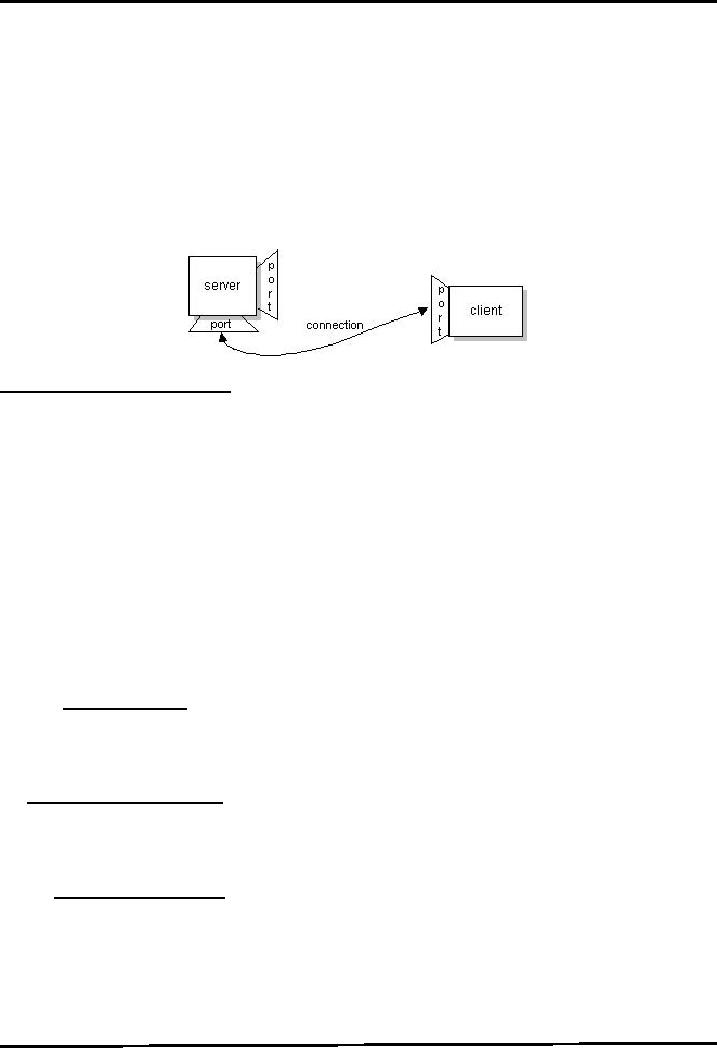
Web
Design & Development CS506
VU
. As
soon as client creates a
socket that socket attempts
to connect to the specified
server.
. The
server listens through a special kind of
socket, which is named as
server socket.
. The
sole purpose of the server
socket is to listen for
incoming request; it is not
used for
communication.
. If
every thing goes well, the
server accepts the connection.
Upon acceptance, the server
gets a new
socket,
a communication socket, bound to a
different port number.
. The
server needs a new socket
(and consequently a different port
number) so that it can
continue to
listen
through the original server
socket for connection
requests while tending to the
needs of the
connected
client. This scheme is
helpful when two or more
clients try to connect to a
server
simultaneously
(a very common scenario).
Steps
To Make a Simple
Client
To
make a client, process can
be split into 5 steps. These
are:
1.
Import required package
You
have to import two
packages
.
java.net.*;
.
java.io.*;
2.
Connect / Open a Socket with
Server
Create
a client socket (communication
socket)
Socket s =
new Socket("serverName", serverPort)
;
Name
or address of the server you
wanted to connect such
as
serverName
:
http://www.google.com
or
172.2.4.98 etc. For testing
if you are
running
client and server on the same machine
then you can
specify
"localhost" as the name of
server
. serverPort
:
Port
number you want to connect
to
The
scheme is very similar to
our home address and then
phone number.
3. Get
I/O Streams of Socket
Get
input & output streams
connected to your
socket
.
For reading data from
socket As stated above, a
socket has input stream
attached to it.
InputStream
is = s.getInputStream();
//
now to convert byte oriented
stream into character
oriented buffered reader // we
use intermediary
stream
that helps in achieving above stated
purpose
InputStreamReader
isr= new InputStreamReader(is);
BufferedReader br = new
BufferedReader(isr);
.
For writing data to
socket
A
socket has also output
stream attached to it.
Therefore,
OutputStream os =
s.getOutputStream();
//
now to convert byte oriented
stream into character
oriented print writer
//
here we will not use
any intermediary stream
because PrintWriter constructor //
directly accepts
an
object of OutputStream
PrintWriter
pw = new PrintWriter(os,
true);
158
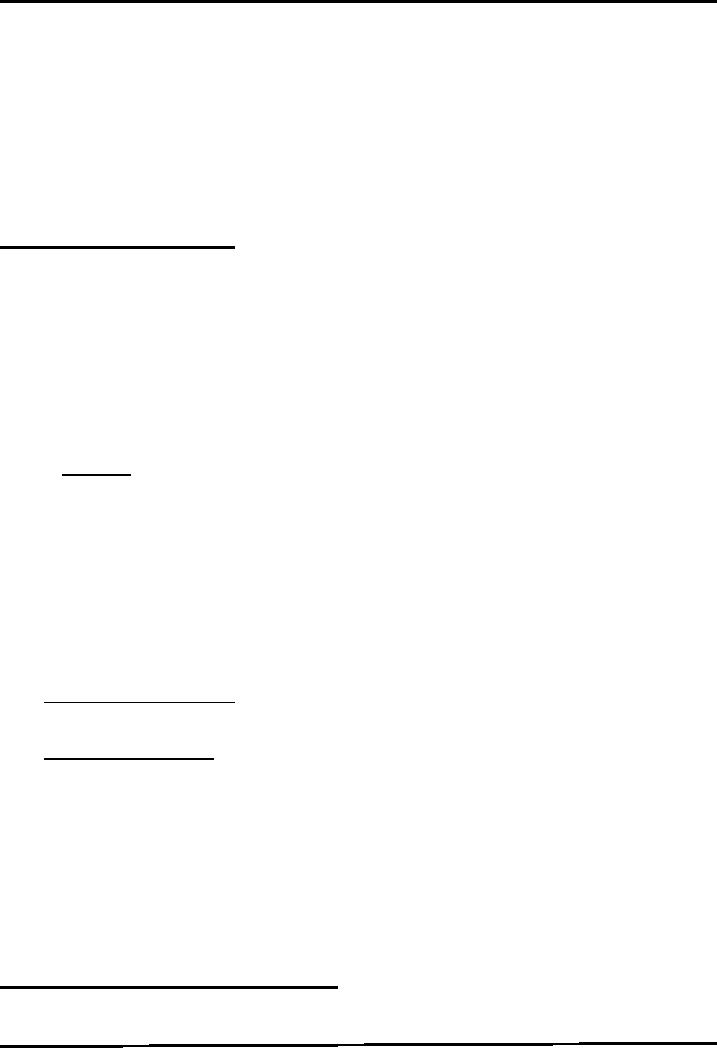
Web
Design & Development CS506
VU
Here
notice that true is also
passed to so that output
buffer will flush.
4. Send
/ Receive Message
Once
you have the streams, sending or
receiving messages isn't a
big task. It's very much
similar to the
way
you did with
files
. To
send messages
pw.println("hello
world");
. To
read messages
String
recMsg = br.readLine();
5.
Close Socket
Don't
forget to close the socket,
when you finished your
work
s.close();
Steps
To Make a Simple
Server
To
make a server, process can be
split into 7 steps. Most of
these are similar to steps
used in making a
client.
These are:
1.
Import required package
You
need the similar set of
packages you have used in
making of client
.
java.net.*;
.
java.io.*;
2. Create a
Server Socket
In
order to create a server
socket, you will need to
specify port no eventually on
which server will
listen
for
client requests.
ServerSocket ss =
new ServerSocket(serverPort) ;
. serverPort:
port local to the server
i.e. a free port on the
server machine. This
is the
same port number that is
given in the client socket
constructor
3. Wait
for Incoming
Connections
The
job of the server socket is to
listen for the incoming connections.
This listening part is
done
through
the accept method.
Socket s =
ss.accept();
The
server program blocks (
stops ) at the accept method and waits
for the incoming client
connection
when
a request for connection
comes it opens a new
communication socket (s) and
use this socket to
communicate
with the client.
4. Get
I/O Streams of Socket
Once
you have the communication socket,
getting I/O streams from
communication socket is similar
to
the
way did in making a
client
1.
For reading data from
socket
InputStream
is = s.getInputStream(); InputStreamReader isr=
new
InputStreamReader(is);
BufferedReader br = new
BufferedReader(isr);
2.
For writing data to
socket
OutputStream os =
s.getOutputStream();
PrintWriter
pw = new PrintWriter(os,
true);
5. Send
/ Receive Message
Sending
and receiving messages is
very similar as discussed in
making of client
To
send messages:
pw.println("hello
world");
. To
read messages
String
recMsg = br.readLine();
6.
Close Socket
s.close();
Example
Code 21.1: Echo Server &
Echo Client
The
client will send its
name to the server and server
will append "hello" with the
name send by the
client.
After
that, server will send back
the name with appended
"hello".
EchoServer.java
159

Web
Design & Development CS506
VU
Let's
first see the code for the
server
//
step 1: importing required
package
import
java.net.*;
import
java.io.*;
import
javax.swing.*;
public
class EchoServer
{
public
static void main(String
args[])
{
try
{
//step 2:
create a server
socket
ServerSocket
ss = new ServerSocket(2222);
System.out.println("Server
started...");
/*
Loop back to the accept method of the
serversocket and wait for a
new connection
request.
Soserver
will continuously listen for
requests
*/
while(true)
{
//
step 3: wait for incoming
connection
Socket
s = ss.accept();
System.out.println("connection
request recieved");
//
step 4: Get I/O
streams
InputStream
is = s.getInputStream();InputStreamReader isr=
new
InputStreamReader(is);BufferedReader
br = new BufferedReader(isr);
OutputStream
os = s.getOutputStream();
PrintWriter
pw = new PrintWriter(os,true);
//
step 5: Send / Receive
message
//
reading name sent by
clientString name = br.readLine();
//
appending "hello" with
the
received
name
String
msg = "Hello " + name + "
from Server"; // sending back to
client
pw.println(msg);
//
closing communication
sockeys.close();
} // end
while
}catch(Exception
ex){
System.out.println(ex);
} } } // end class
EchoClient.java
The
code of the client is given
below
//
step 1: importing required
package
import
java.net.*;import java.io.*;import
javax.swing.*;
public
class EchoClient{
public
static void main(String
args[]){
try
{
//step 2:
create a communication
socket
// if
your server will run on the
same machine thenyou can
pass "localhost" as server
address */
/*
Notice that port no is
similar to one passedwhile creating
server socket
*/server
Socket
s = new Socket("localhost",
2222);
//
step 3: Get I/O
streams
InputStream
is = s.getInputStream();InputStreamReader isr=
new
InputStreamReader(is);BufferedReader
br = new BufferedReader(isr);
OutputStream
os = s.getOutputStream();PrintWriter pw =
new
160
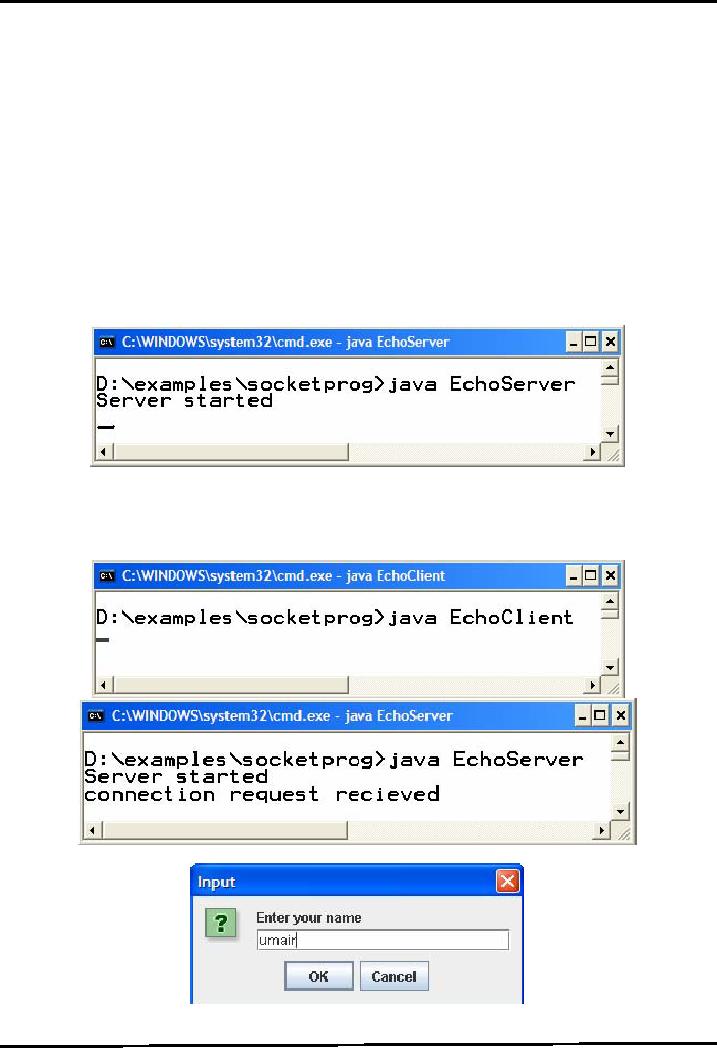
Web
Design & Development CS506
VU
PrintWriter(os,true);
//
step 4: Send / Receive
message
//
asking use to enter his/her
name
String
msg = JOptionPane.showInputDialog("Enter
your name");
// sending
name to server
pw.println(msg);
//
reading message (name
appended with hello) from//
servermsg = br.readLine();
//
displaying received
messageJOptionPane.showMessageDialog(null ,
msg);
//
closing communication
sockets.close();
}catch(Exception
ex){ System.out.println(ex); } } }
//
end class
Compile
& Execute
After
compiling both files, run
EchoServer.java first, from the
command prompt window.
You'll see a
message
of "server started" as shown in the
figure below. Also notice
that cursor is continuously
blinking
since
server is waiting for client
request
Now,
open another command prompt window
and run EchoClient.java from
it. Look at EchoServer
window;
you'll see the message of
"request received". Sooner, the
EchoClient program will ask
you to
enter
name in input dialog box.
After entering name press ok
button, with in no time, a
message dialog box
will
pop up containing your name
with appended "hello" from
server. This whole process is
illustrated
below
in pictorial form:
sending
name to server
response
from server
161
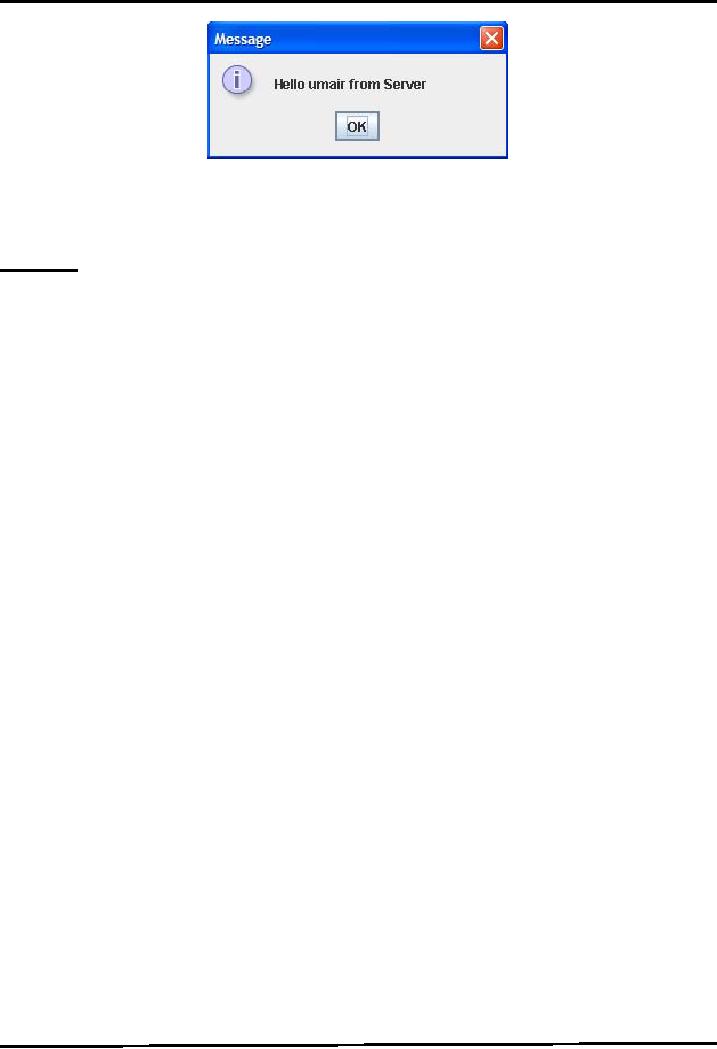
Web
Design & Development CS506
VU
Notice
that server is still
running, you can run
again EchoClient.java as many times
untill server is
running.
To have more
fun, run the server on a
different computer and client on a
different. But before doing
that
find
the IP of the computer machine on which your
EchoServer will eventually run.
Replace "localhost"
with
the new IP and start conversion
over network ☺
References
Entire
material for this handout is
taken from the book JAVA A
Lab Course by Umair
Javed.
This
material
is available just for the
use of VU students of the course Web
Design and Development and not
for
any
other commercial purpose without the
consent of author.
162
Table of Contents:
- JAVA FEATURES
- Java Virtual Machine & Runtime Environment
- Learning Basics of JAVA
- JAVA: Object Oriented Programming
- JAVA: Inheritance
- JAVA: Collections
- JAVA: Intro to Exceptions
- JAVA: Streams
- JAVA: Modification of Address Book Code
- JAVA: Graphical User Interfaces
- JAVA: Event Handling
- JAVA: More Examples of Handling Events
- JAVA: Problem in Last Code Example
- Java Database Connectivity
- JAVA: More on JDBC
- JAVA: Result Set
- JAVA: Meta Data
- Java Graphics
- JAVA: How to Animate
- JAVA Applets
- JAVA: Socket Programming
- JAVA: Serialization
- JAVA: Multithreading 1
- JAVA: Multithreading 2
- JAVA Web Application Development
- Java Servlets
- JAVA: Creating a Simple Web Application in Tomcat
- JAVA: Servlets Lifecycle
- JAVA: More on Servlets
- JAVA: Dispatching Requests
- JAVA: Session Tracking 1
- JAVA: Session Tracking 2
- JAVA: AddressBook Case Study Using Sevlets
- Java Server Pages 1
- JavaServer Pages 2
- Java Server Pages 3
- JAVA: JSP Action Elements and Scope
- JAVA: JSP Custom Tags
- JAVA: MVC + Case Study
- JAVA: MVC Model 2 Architecture
- JAVA: Layers and Tiers
- JAVA: Expression Language
- JAVA: JavaServer Pages Standard Tag Library (JSTL)
- JAVA: Client Side Validation & JavaServer Faces (JSF)
- JAVA: JavaServer Faces